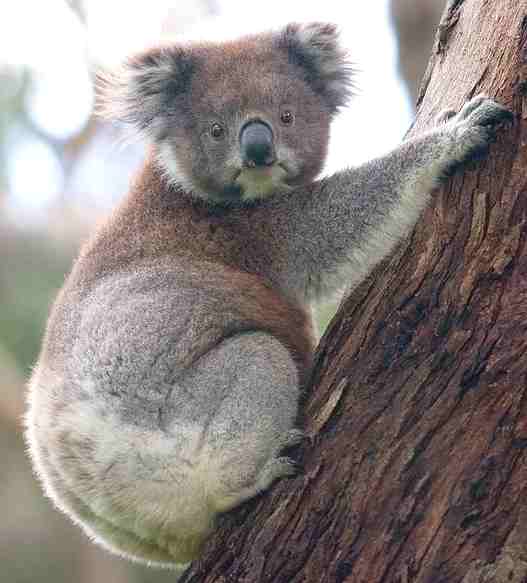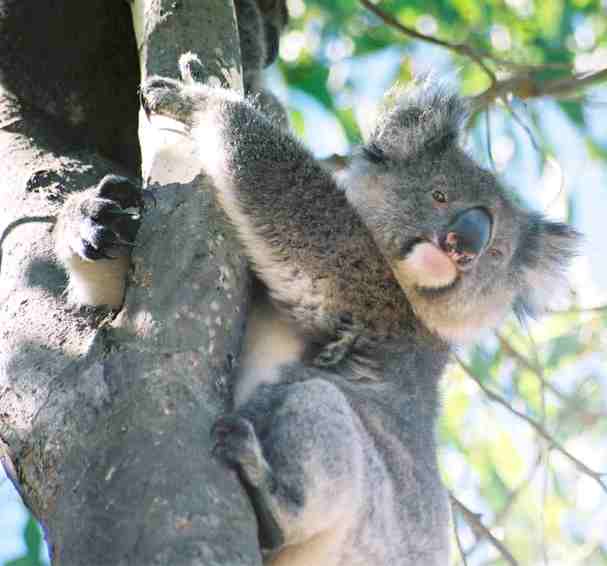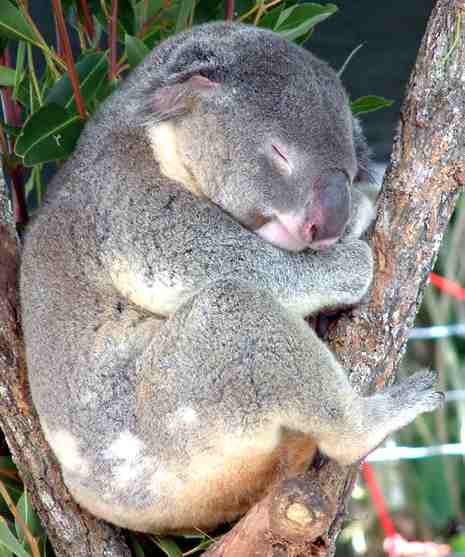|
KOALA BEARS
|
|||||||||||||||||||||||||||||||||||||||||||||||
|
HOME | BIOLOGY | FILMS | GEOGRAPHY | HISTORY | INDEX | INVESTORS | MUSIC | SOLAR BOATS | SPORT |
|||||||||||||||||||||||||||||||||||||||||||||||
The Koala (Phascolarctos cinereus) is a thickset arboreal marsupial herbivore native to Australia, and the only extant representative of the family Phascolarctidae.
The Koala is found all along the eastern coast of Australia from near Adelaide to the southern part of Cape York Peninsula, and as far into the hinterland as there is enough rainfall to support suitable forests. The Koalas of South Australia were largely exterminated during the early part of the 20th century, but the state has since been repopulated with Victorian stock. The Koala is not found in Tasmania or Western Australia.
Koala Bear climbing a tree
The word "koala" comes from the Dharuk word gula. Closely related words appear in other Australian Aboriginal languages, including:
It is commonly said that the common name 'Koala' is an Aboriginal word meaning "no drink" although there is no evidence to support such an idea. Additionally such an idea is factually incorrect as Koalas do drink water, but only rarely, due to their diet consisting of eucalypt leaves, which contain sufficient water to obviate the need for the Koala to descend to ground level to drink.
Early European settlers to Australia called the Koala the Native Bear, and the Koala is still sometimes called the Koala Bear, but it is not a member of the bear family. In fact, it is not even a placental mammal (which most mammals are) - it is a marsupial. The Koala's scientific name (Phascolarctos cinereus) comes from the Greek: phaskolos meaning "pouch" and; arktos meaning "bear". The cinereus epithet is Latin and means "ash-coloured".
Variation
Although three subspecies have been described, these are arbitrary selections from a cline and are not generally accepted as valid. Following Bergmann's Rule, southern individuals from the cooler climates are larger. A typical Victorian Koala (formerly P. cinereus victor) has longer, thicker fur, is a darker, softer grey, often with chocolate-brown highlights on the back and forearms, and has a more prominently light-coloured ventral side and fluffy white ear tufts. Typical and New South Wales Koala weights are 12 kg for males and 8.5 kg for females. In tropical and sub-tropical Queensland, however, the Koala is smaller (at around 6.5 kg for an average male and just over 5 kg for an average female), a lighter, often rather scruffy grey in colour, and has shorter, thinner fur. In Queensland the Koala was previously classified as the subspecies P. cinereus adustus, and the intermediate forms in New South Wales as P. cinereus cinereus. The variation from one form to another is continuous and there are substantial differences between individual Koalas in any given region such as hair colour. The origins of the koala are unclear, although almost certainly they descended from terrestrial wombat-like animals. Koala fossils are quite rare, but some have been found in northern Australia dating to 20 million years ago. During this time, the northern half of Australia was rainforest. The Koala did not specialise in a diet of eucalypts until the climate cooled and eucalypts forests grew in the place of rainforests. The fossil record indicates that before 50,000 years ago, Giant Koalas inhabited the southern regions of Australia. The Koala fills the same ecological role as the sloth of South America.
Physical description
The Koala is broadly similar in appearance to the wombats (the closest living relatives), but has a thicker, more luxurious coat, much larger ears, and longer limbs, which are equipped with large, sharp claws to assist with climbing. Weight varies from about 14 kg for a large, southern male, to about 5 kg for a small northern female. Contrary to popular belief, their fur is thick, not soft and cuddly. Koalas' five digits are arranged with opposable thumbs, providing better gripping ability. The first two digits are position in apposition on the front paws, and the first three digits for the hind paws. The Koala is one of the few mammals (other than primates) that has fingerprints. In fact, koala fingerprints are remarkably similar to human fingerprints; even with an electron microscope, it can be quite difficult to distinguish between the two.
The Koala has an unusually small brain, with about 40% of the cranial cavity being filled with fluid, while the brain itself is like "a pair of shrivelled walnut halves on top of the brain stem, in contact neither with each other nor the bones of the skull. It is the only animal on Earth with such a strangely reduced brain."
It is a generally silent animal, but males have a very loud advertising call that can be heard from almost a kilometre away during the breeding season. There is little reliable information about the lifespan of the Koala, but in captivity they have been observed to reach the age of 15 years.
The inverted thumbs on the Koala's back feet help for grip while the koala changes branches or eats with its front hands.
Southern Koala on Kangaroo Island, not native to the island
Life cycle
Females reach maturity at 2 to 3 years of age, males at 3 to 4 years. If healthy, a female Koala can produce one young each year for about 12 years. Gestation is 35 days; twins are very rare. Mating normally occurs between December and March, the Southern Hemisphere's summer.
A baby Koala is referred to as a joey and is hairless, blind, and earless. At birth the joey, only a quarter of an inch long, crawls into the downward-facing pouch on the mother's belly (which is closed by a drawstring-like muscle that the mother can tighten at will) and attaches itself to one of the two teats. Koalas retain the rearward-facing pouch of their terrestrial vomaboid ancestors. Young remain hidden in the pouch for about six months, only feeding on milk. During this time they grow ears, eyes, and fur. The joey then begins to explore outside of the pouch. At about this stage it begins to consume small quantities of the semi-liquid form of the motherís excrement called "pap" in order to inoculate its gut with the microbes necessary to digest eucalypt leaves. The baby Koala will remain with the mother for another six months or so, riding on her back, and feeding on both milk and gum leaves until weaning is complete at about 12 months of age. Young females disperse to nearby areas at that time; young males often stay in the mother's home range until they are two or three years old.
Ecology and behaviour
The Koala lives almost entirely on eucalypt leaves. This is likely to be an evolutionary adaptation that takes advantage of an otherwise unfilled ecological niche, since eucalypt leaves are low in protein, high in indigestible substances, and contain phenolic and terpene compounds that are toxic to most species. Like wombats and sloths, the Koala has a very low metabolic rate for a mammal and rests motionless for about 19 hours a day, sleeping most of that time. Koalas that are disturbed are known to be violent, their teeth and claws capable of providing considerable injury to humans; special handling requirements are as such applicable. Handling of koalas has been a source of political contention due to these risks, which can also cause harm to the koala as well. Koalas spend about three of their five active hours eating. Feeding occurs at any time of day, but usually at night. An average Koala eats 500 grams of eucalypt leaves each day, chewing them in its powerful jaws to a very fine paste before swallowing. The liver deactivates the toxic components ready for excretion, and the hind gut (especially the caecum) is greatly enlarged to extract the maximum amount of nutrient from the poor quality diet. Much of this is done through bacterial fermentation: when young are being weaned, the mother passes unusually soft faeces, called pap, which is rich in these bacteria, thus passing these essential digestive aids on to her offspring. The Koala will eat the leaves of a wide range of eucalypts, and occasionally even some non-eucalypt species, but it has firm preferences for particular varieties. These preferences vary from one region to another: in the south Manna Gum, Blue Gum and Swamp Gum are favoured; Grey Gum and Tallowwood are important in the north, and the ubiquitous River Red Gum of the isolated seasonal swamps and watercourses that meander across the dry inland plains allows the Koala to exist in surprisingly arid areas. Many factors determine which of the 800 species of eucalypt trees the Koala eats. Among trees of their favourite species, however, the major factor that determines which individual trees the Koala chooses is the concentration of a group of phenolic toxins called formylated phloroglucinol compounds.
Conservation status
The Koala was hunted almost to extinction in the early 20th century, largely for its fur. In recent years, some colonies have been hard hit by disease, especially chlamydia. The Koala requires large areas of healthy, connected forest and will travel long distances along tree corridors in search of new territory and mates. The ever-increasing human population of the coastal parts of the continent continues to cut these corridors by agricultural and residential development, forestry and road-building, marooning Koala colonies in decreasing areas of bush. The Australian Koala Foundation has mapped 40,000 sq.km. of land for Koala habitat and claims it has strong evidence to suggest wild Koala populations are in serious decline throughout the species natural range. Although the species covers a massive area, only 'pieces' of Koala habitat remain. These pieces need to be managed, protected and restored in a coordinated way. Presently, many are being lost to weeds, cleared for agriculture, or carved up by developers. Other threats come from logging, poor management, attacks from feral and domestic animals, disease and roads.
In contrast to the situation on much of the mainland, where populations are declining, the Koalas of many island and isolated populations have reached what some have described as "plague" proportions. On Kangaroo Island in South Australia, Koalas introduced some 90 years ago have thrived in the absence of predators and competition. Combined with an inability to migrate to new areas, this has caused the Koala populations to become unsustainable and threaten the Island's unique ecology. In particular, species of Manna Gum, native to the island, are being stripped by Koalas at a rate faster than they can regenerate, endangering local birds and invertebrates that rely on them, and causing the extinction of at least one isolated population of manna. Koala numbers are estimated at over 30,000, with ecologists suggesting that the Island can sustain 10,000 at most. Although culling has been suggested as a means to reduce Koala numbers, with the South Australian Government seriously considering such in 1996, this has met with fierce opposition both domestically and internationally, and the species remains protected. The popularity of the Koala has made the possibility of a cull politically improbable, with any negative perception likely to impact tourism and a government's electability. In place of a cull, sterilisation and translocation programmes have had only limited success in reducing numbers thus far, and remain expensive. There is evidence that Koalas relocated to the mainland have difficulty establishing themselves in the different circumstances. A mooted alternative to the complex sterilisation method, wherein the animal must first be captured, are hormonal implants that can be injected via darts.
The Koala inhabits four Australian states. Under state legislation, the species is listed as:
A review of the species national conservation status concluded that the koala are not threatened at a national scale, with a population that numbers in the hundreds of thousands. This was the third review undertaken by the federal government that came to this conclusion. The IUCN lists the species as "Lower Risk / Near Threatened".
As with most native Australian animals, the Koala cannot legally be kept as a pet in Australia without a permit.
In popular Western culture, the animal is usually either depicted as a cuddly innocent, or as a curmudgeonly character never terribly impressed by the things he sees around him.
Koala in a park at Cairns, Australia
LINKS and REFERENCE
MARSUPIALS:
Please use the Index below to navigate the Animal Kingdom:-
A taste for adventure
A heartwarming adventure: pirate whalers V conservationists
|
|||||||||||||||||||||||||||||||||||||||||||||||
|
This website is Copyright © 1999 & 2012 NJK. The bird logos and name Solar Navigator are trademarks. All rights reserved. All other trademarks are hereby acknowledged. Max Energy Limited is an educational charity working for world peace. |
|||||||||||||||||||||||||||||||||||||||||||||||
|
AUTOMOTIVE | BLUEBIRD | ELECTRIC CARS | ELECTRIC CYCLES | SOLAR CARS |


